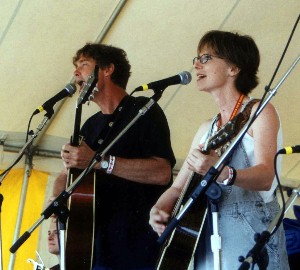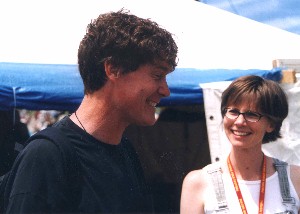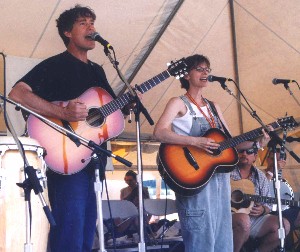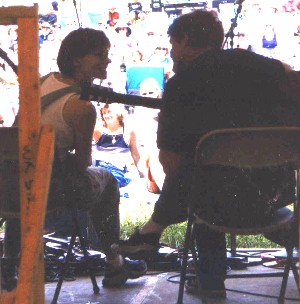 Caged Shapeshifters
Caged Shapeshifters
Story by Gary Alexander
Photos by Ray G. Ring IV
A review of Dave Carter and Tracy Grammer and their
recent album Drum Hat Buddha prior to their appearance
at the Rosendale Cafe, Wednedsday, October 10, 2001.
When
you're part-coyote and part-hummingbird, you look a little
different as the quality of light changes. Shadow and highlight may
reveal other genetic ingredients of your form. Gryphons and centaurs
spring to mind as your eyes attempt to focus in the reflecting pool and
myriad other beasts with at least one part "man" in their constitution,
spilled from a jiggle of exploratory DNA blending.
In the music of Dave Carter and Tracy Grammer, who will be
appearing Wednesday night (September 10, 2001) at the
Rosendale Cafe,
we
find another stage in the duo's metamorphic veer from acoustic obscurity
to commercial clammor via their latest album
Drum Hat Buddha.
It is a
bit like harkening to the distant, nature-wedded howl of a caged
shapeshifter.
In one of his early books, William Irwin Thompson (who spoke
recently in Woodstock), observed that "(t)he persistence of myth is
irresistible, and though we have changed the content of history, we seem
never to have altered its mythic structure."
As a songwriter, Dave Carter is sly master of the archetypes of
American dream and myth and, lyrically, his instincts do not fail him on
the new offering. Time and again his characters and thoughts emerge from
the misted core of human imagination in all of its regional and
situational variation. Merlin mingles amongst truckdrivers and biblical
prophets stumble almost unnoticed past Murphy's desk in accounting while
Saladin poses in a porkpie hat. The aspirations and oppositions remain
ageless and liquid like the baseball player etched faintly into the
centerpage of the cd's booklet, coiled in a batting stance, about to
take a wack at the 30 foot serpent moving toward him.
 In bringing his mythic heroes onto a modern stage, Carter
injects human responses familiar to all of us, displaying a
multi-leveled awareness of contemporary culture as acute as his grasp of
the internal and eternal streams of perception upon which he navigates
his canoe of poetry. Unnamed, specified or implied, Carter's
protaganists are tenderly guided into the listener's sympathies where
they can be "normalized" and cared about but the point is- he knows each
of them as well as he knows us.
In bringing his mythic heroes onto a modern stage, Carter
injects human responses familiar to all of us, displaying a
multi-leveled awareness of contemporary culture as acute as his grasp of
the internal and eternal streams of perception upon which he navigates
his canoe of poetry. Unnamed, specified or implied, Carter's
protaganists are tenderly guided into the listener's sympathies where
they can be "normalized" and cared about but the point is- he knows each
of them as well as he knows us.
In
Myths, Dreams and Mysteries,
Mircea Eliade pointed out:
"Critical writers have often pointed out modern versions of, for
example, Don Juan, the political or the military hero, the hapless
lover; of the cynic, the nihilist, the melancholy poet, and so forth;
all these models are carrying on mythological traditions which their
topical forms reveal in mythical behavior. The copying of these
archetypes betrays a certain discontent with one's own personal history;
an obscure striving to transcend one's own local, provincial history and
to recover some 'Great Time' or other- though it be only the mythic Time
of the first surrealist or existentialist manifesto."

At Falcon Ridge 2001, Carter's hair is longer
and Tracy's shorter as their music still enthralls.
Here, at an afternoon tribute to the songs of
Bob Dylan, they perform a stunning version of
"Farewell Angelina".
|
Carter's own discontent spurs his inspiration while his
recognition that his is not an isolated malady gives him the wisdom to
usher us all into the coach for the ride. Or, as William Irwin Thompson
put it; "At the edge of history, history itself can no longer help us,
and only myth remains equal to reality." Admittedly, such out-of-the-hat
declarations leave much to be explained while his lyrics contain just as
much which should not be "explained." Carter's comprehension of all of
this, however,
can
be explained by a
dedication to mythic structure
(see article
Dreamer and
the Butterfly)
predating the current minstrel cycle
during which
he rubbed elbows, however briefly, with the likes of mythmaster Joseph
Campbell.
One troublesome drawback to the new album is the production
"cage" into which it has been set. With some exceptions, many of its
dozen beguiling songs are cast into unsuitable modes. The free flow of
their catchy and would-be haunting melodies are diced by staccato
unbecoming to their essence. It is much akin to the common
miscalculations of a songwriter who brings his tour band into the studio
to record without adjusting to the very different dynamics of the room
or going back to the natural rhythms of the song's initial emergence.
In this case, because Carter and Grammer perform most
often as a duo, it might be subtitled "Dave and Tracy Go Pop." Drum,
first in title, comes out first in production as well, replacing the
restrained percussion of previous efforts with snares mixed up to pop
levels to sound like artists A, B and C demonstrating the pressure of
chart wannabes stripping off individualities which don't fit the mold.
 Rather than reflecting upon the considerable
percussional talents of Lorne Entress, who graced the duo's
Tanglewood Tree
album, helping to make it one of the finest artistic successes of
last year in any category, it might indeed reflect upon the habitual
unconscious poise of playing to the crowd, which Carter and Grammer has
seemed to do endlessly, crisscrossing the country in the past year,
rather than playing to the song. That much is unfortunate in the more
intimate dynamics of the recording studio and in relation to the
qualities which distinguish their music as something quite apart from
the mainstream standard. The subtle interplay of vocal and string
rhythms which makes their sound so extraordinary is too often diminished
or entirely washed out on
Drum Hat Buddhah
by an insistence of beat
which plays like barbed wire around a patch of daisys.
Rather than reflecting upon the considerable
percussional talents of Lorne Entress, who graced the duo's
Tanglewood Tree
album, helping to make it one of the finest artistic successes of
last year in any category, it might indeed reflect upon the habitual
unconscious poise of playing to the crowd, which Carter and Grammer has
seemed to do endlessly, crisscrossing the country in the past year,
rather than playing to the song. That much is unfortunate in the more
intimate dynamics of the recording studio and in relation to the
qualities which distinguish their music as something quite apart from
the mainstream standard. The subtle interplay of vocal and string
rhythms which makes their sound so extraordinary is too often diminished
or entirely washed out on
Drum Hat Buddhah
by an insistence of beat
which plays like barbed wire around a patch of daisys.
On the positive side, the underlying songwriting
soars and races, winds and involves, just as before and Grammer's
exquisite vocal contributions increase their number of leads as her
instrumental bracings shine on. Hearing these new songs in a "live"
environment is a must for those who would follow the development of this
rare musical team. They came to the Falcon Ridge Festival in the Hudson
Valley from their Oregon base as relative unknowns in August of 2000 and
delighted a surprised audience so dramatically with a much-too-brief
afternoon performance, that they not only returned in 2001 as a
headlining act but emerged as easily one of the most memorable
highlights of the entire weekend. Hearing these songs escape the cage is
an imperative for Wednesday evening. Come and catch the real source of
this magic...
-Gary Alexander
Gary Alexander
is an independent journalist and scholar whose focus of
interests range through a variety of disciplines. Under various names,
he has written (and ghost written) upon history and current event;
science and technology, as well as music and the arts in books and for
national periodicals. While particularly attentive to the subtle and
complex impact upon cultural imagination and contemporary structures of
presumption which activity in the above mentioned topics tend to have,
Alexander treats his topics with a slightly more than occasional resort
to humor.
Posted on October 5, 2001
|

